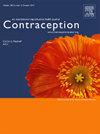Pharmacist-prescribed contraception using clinical protocols: A review of the gray literature
IF 2.3
2区 医学
Q1 OBSTETRICS & GYNECOLOGY
引用次数: 0
Abstract
Background
Many women face barriers to starting and continuing contraception due to difficulties in accessing primary care. Pharmacist-prescribed contraceptives have emerged as a strategy to improve access. This approach offers an additional pathway for women to access contraceptive care, with benefits such as lower costs, shorter wait times, and extended hours.
Objectives
This review aims to analyze clinical protocols used by community pharmacists to prescribe and continue hormonal contraceptives and evaluate their quality.
Study design
This review utilized gray literature since protocols are often not formally published. The search involved four processes: searching a gray literature database, using Google, reviewing health agency websites, and consulting international experts. Records were included if they met the definition of a clinical protocol, were for community pharmacist prescribing or continuation of hormonal contraception, and were written in English. Grounded Theory was used for analysis. Quality appraisal was performed using the Appraisal of Guidelines for Research and Evaluation II tool.
Results
Thirty clinical protocols were identified from the USA (n = 23), Canada (n = 2), the UK (n = 2), New Zealand (n = 1), and Australia (n = 2). Pharmacists were authorized to prescribe and continue contraceptives in 27 protocols and continue contraceptives only in three. Key requirements included age restrictions, measurement of blood pressure and body mass index, review by a health professional, patient self-completed screening tools, and use of best-practice guidelines. The lowest-scoring domains in the quality assessment were “Editorial Independence,” “Applicability,” and “Rigor of Development.”
Conclusions
The review provides insights into the current international landscape of pharmacist-prescribed contraception and highlights key components of clinical protocols. It offers valuable information for policymakers to support the development of frameworks for pharmacist-prescribed contraception globally.
药剂师处方避孕使用临床方案:灰色文献的回顾。
背景:由于难以获得初级保健,许多妇女在开始和继续避孕方面面临障碍。药剂师处方避孕药已成为改善获取途径的一种策略。这种方法为妇女提供了获得避孕护理的额外途径,其好处包括成本降低、等待时间缩短和工作时间延长。目的:分析社区药师处方和持续使用激素避孕药的临床方案,并评价其质量。方法:本综述利用灰色文献,因为方案往往没有正式发表。这项研究涉及四个过程:搜索灰色文献数据库、使用谷歌、审查卫生机构网站以及咨询国际专家。如果符合临床协议的定义,社区药剂师开的处方或继续使用激素避孕的记录都被包括在内,并以英文书写。采用扎根理论进行分析。使用AGREE II工具进行质量评估。结果:从美国(n = 23)、加拿大(n = 2)、英国(n = 2)、新西兰(n = 1)和澳大利亚(n = 2)确定了30个临床方案。药剂师被授权在27个方案中开处方和继续使用避孕药具,仅在3个方案中继续使用避孕药具。主要要求包括年龄限制、测量血压和体重指数、由卫生专业人员进行审查、患者自行完成筛查工具和使用最佳做法指南。在质量评估中得分最低的领域是“编辑独立性”、“适用性”和“开发的严谨性”。结论:该综述提供了对当前国际药剂师处方避孕的见解,并强调了临床方案的关键组成部分。它为政策制定者提供了宝贵的信息,以支持全球药剂师处方避孕框架的发展。
本文章由计算机程序翻译,如有差异,请以英文原文为准。
求助全文
约1分钟内获得全文
求助全文
来源期刊

Contraception
医学-妇产科学
CiteScore
4.70
自引率
17.20%
发文量
211
审稿时长
69 days
期刊介绍:
Contraception has an open access mirror journal Contraception: X, sharing the same aims and scope, editorial team, submission system and rigorous peer review.
The journal Contraception wishes to advance reproductive health through the rapid publication of the best and most interesting new scholarship regarding contraception and related fields such as abortion. The journal welcomes manuscripts from investigators working in the laboratory, clinical and social sciences, as well as public health and health professions education.
 求助内容:
求助内容: 应助结果提醒方式:
应助结果提醒方式:


